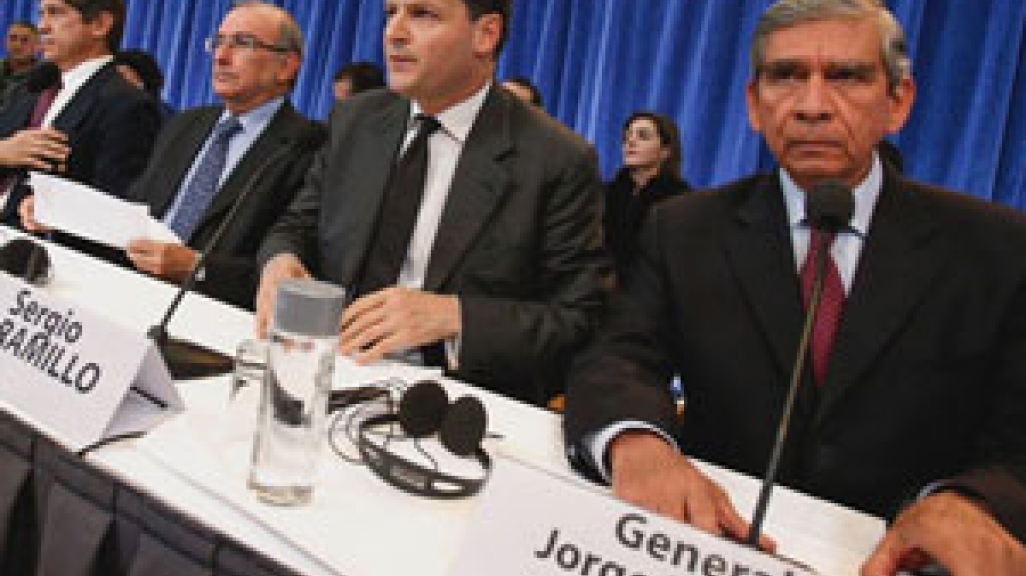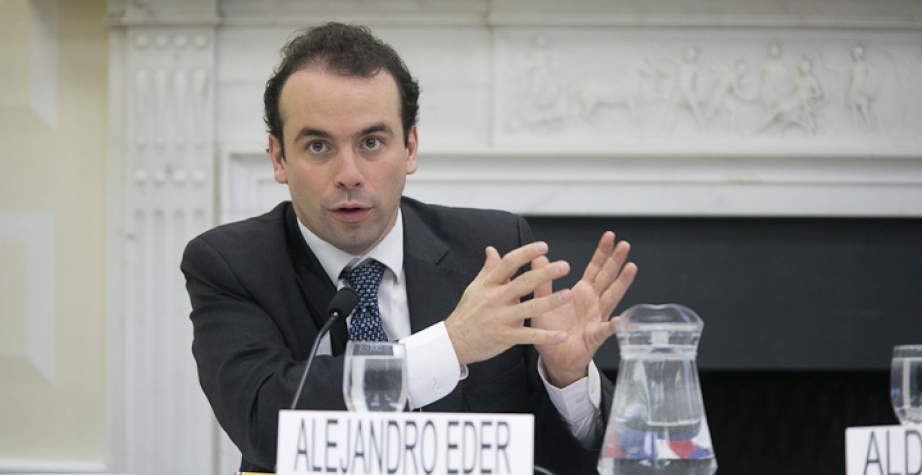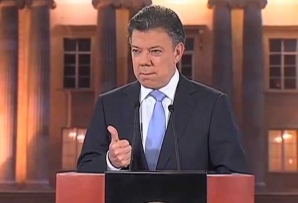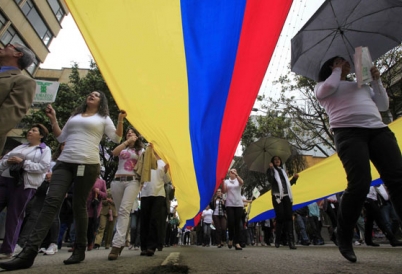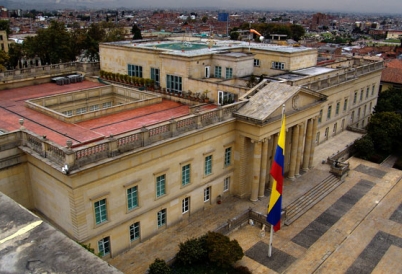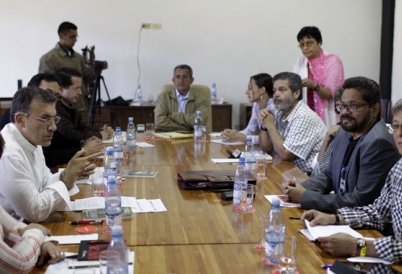Guide: Colombia's Peace Talks
Guide: Colombia's Peace Talks
Colombian President Juan Manuel Santos signed a preliminary agreement in Havana on August 27, 2012 to begin peace talks with the guerrilla group Revolutionary Armed Forces of Colombia, known more commonly as the FARC. The talks began in October 2012 in Norway, and then moved to Cuba the following month. In an effort to bring an end to the nearly half-century-long conflict, the government’s efforts came after the passage of a Legal Framework for Peace—a bill passed by Colombia’s Congress and sanctioned by Santos in June 2012. The peace talks also follow the deaths of top FARC leaders, including Mono Jojoy in 2010 and Alfonso Cano in 2011. The National Liberation Army, or ELN, the country’s second largest guerrilla faction, agreed to join the peace talks in September 2013.
In an effort to deliver the latest on the peace talks, AS/COA Online offers a collection of links to primary sources, news coverage, and multimedia content.
Image: AP Photo. Rachel Glickhouse and Mark Keller contributed to this guide, originally published on August 28, 2012.
Timeline
See major milestones in the current round of peace talks:
- August 27: Colombian President Juan Manuel Santos signed a preliminary agreement in Havana, Cuba to begin peace talks with the guerrilla group Revolutionary Armed Forces of Colombia.
- August 28: Authorities arrested seven people accused of attempting to kill former Interior Minister Fernando Londoño in May; police say the suspects may have been hired by the FARC.
- September 4: Santos and FARC leaders announced they had signed an agreement to begin the peace process.
- October 18: Negotiators from the Colombian government and the FARC held a press conference in Norway to mark the start of the process.
- October 22: The Colombian government lifted 191 arrest warrants in order for 29 FARC negotiators to participate in the talks. Attorney General Eduardo Montealegre explained that the suspensions were only valid in Norway and Cuba, where negotiations will take place. "If one of the 29 FARC members goes to a place unauthorized by the government or peace commissioner, arrest orders will be made," he said.
- November 6: After initial dialogues in Oslo, representatives from both sides moved to Havana to discuss logistics ahead of the official start to talks.
- November 12: In a letter, the National Liberation Army (ELN) expressed a desire to begin exploratory talks to potentially join the peace process.
- November 19: Talks got underway officially in Havana, Cuba. As the talks began, FARC announced a two-month unilateral ceasefire.
- November 25: Negotiators announced a public forum on agrarian reform to be held in Bogota in December.
- November 29: The first round of Havana talks ended. The government announced the launch of a website for citizens to contribute to discussions on the peace talks.
- December 2: Santos set a November 2013 deadline for the end of the talks.
- December 19: The three-day public forum on agricultural reform concluded in Bogota.
- January 14: During the January round of talks, both sides discussed the proposals on agrarian reform that emerged during the December public forum in Bogota.
- January 20: The FARC announced its unilateral two-month ceasefire would not be extended.
- January 24: A government ceasefire still remained off the table, negotiator Humberto de la Calle said.
- May 26: In a joint statement, negotiators said that they reached an agreement on land reform.
- June 11, 2013: Negotiators begin the tenth round of talks, and broach the second agenda topic on political participation for former FARC guerrillas. FARC representatives propose delaying the 2014 legislative and presidential elections by a year, and put forward the idea of a constituent assembly. Humberto de la Calle, the chief government negotiator, says no to both proposals.
- July 1, 2013: In a joint statement, representatives of the FARC and ELN say they held a joint meeting and agreed to work towards “a political solution to the social and armed conflict.” http://farc-ep.co/?p=2404
- August 22, 2013: Santos announces a plan to submit an eventual peace accord to a public referendum.
- August 23, 2013: FARC negotiators suspend the talks to consider the government’s proposal for a referendum on a future peace accord.
- August 26, 2013: Despite the brief suspension, negotiations resume in Havana.
- August 28, 2013: Colombia’s Constitutional Court upholds the Legal Framework for Peace, a critical piece of legislation for the talks.
- September 1, 2013: The Santos administration sends a bill to Congress to hold a referendum on a future peace accord.
- September 9, 2013: The government announces it will begin talks with the ELN, in a different location from the FARC talks in Havana.
- September 11, 2013: A bicameral committee in Congress postpones debate on the peace referendum.
- September 17, 2013: The peace accord referendum bill passes its first hurdle in Congress, and is approved by committees in both houses. The bill will now be debated by the House and the Senate.
- September 24, 2013: Santos asks for global support for the peace process during his address at the General Debate of the UN General Assembly.
This is not the first time the Colombian government will attempt negotiations with the FARC. In the past 30 years, nearly every Colombian leader attempted negotiations in some way. The most extensive of these was undertaken by President Andrés Pastrana from 1999 to 2002 in the so-called Caguan Peace Talks. In preparation for those talks, Pastrana called a ceasefire with the FARC and agreed to demilitarize a 42,000 square mile area of the country. However, the FARC refused to cooperate and instead used the demilitarized zone as a training ground for new fighters, redoubling its drug trafficking operations. Pastrana called off the talks with the FARC in 2002. No talks were held under his successor, Álvaro Uribe (2002-2010).
A number of Colombian and international press outlets feature timelines of the FARC’s history, conflict with the Colombian state, and the failed Caguan negotiations.
- Colombia’s El Tiempo reports on peace attempts made by past Colombian presidents, beginning with Belisario Betancur Cuartas (1982-1986). The Colombia daily also offers an infographic of past peace talks, beginning with FARC negotiations in 1982 to the Pastrana administration talks that ended in 2002.
- Colombia’s Terra provides a timeline of the FARC’s history since its 1964 founding.
- Spain’s RTVE and El Mundo detail the largest happenings in the battle between the FARC and the Colombian state over the past 15 years.
- The New York Times provides a timeline of the conflict dating back to the 1964 establishment of the FARC and accompanied by highlights of its news coverage.
AS/COA hosted a conversation with Alejandro Eder, who discussed Colombia's peacebuilding and reintegration experience.







